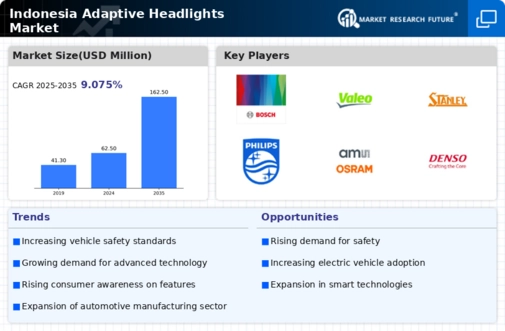Rising Vehicle Production
The adaptive headlights market in Indonesia is expected to grow due to increasing vehicle production. As the automotive industry expands, manufacturers are incorporating advanced technologies, including adaptive headlights, to enhance vehicle safety and performance. In 2025, Indonesia's automotive production is projected to reach approximately 1.5 million units, reflecting a growth rate of around 5% from previous years. This surge in vehicle production creates a substantial demand for innovative lighting solutions, positioning adaptive headlights as a key feature in new models. The integration of adaptive headlights not only improves visibility but also aligns with consumer preferences for modern, high-tech vehicles. Consequently, the rising vehicle production in Indonesia serves as a significant driver for the adaptive headlights market, as manufacturers strive to meet the evolving demands of consumers and regulatory standards.
Government Initiatives for Road Safety
Government initiatives aimed at enhancing road safety influence the adaptive headlights market in Indonesia. The Indonesian government has been actively promoting road safety measures, which include the adoption of advanced vehicle technologies. In recent years, there has been a noticeable push for regulations that encourage the use of adaptive headlights, as they significantly improve nighttime visibility and reduce accident rates. Reports indicate that countries with adaptive lighting systems have seen a reduction in nighttime accidents by up to 30%. As the government continues to prioritize road safety, the adaptive headlights market is expected to benefit from increased regulatory support and incentives for manufacturers to incorporate these technologies into their vehicles.
Increasing Urbanization and Traffic Density
Increasing urbanization and traffic density in major cities position the adaptive headlights market in Indonesia for growth. As urban areas expand, the number of vehicles on the road continues to rise, leading to more challenging driving conditions, particularly at night. The need for improved visibility in congested urban environments is becoming increasingly apparent, driving demand for adaptive headlights that can adjust to varying traffic conditions. Reports suggest that urban areas in Indonesia are experiencing a population growth rate of approximately 3% annually, contributing to higher vehicle ownership and usage. This trend underscores the necessity for advanced lighting solutions, positioning the adaptive headlights market as a critical component in addressing the safety and visibility challenges faced by urban drivers.
Consumer Demand for Enhanced Safety Features
In Indonesia, the adaptive headlights market is driven by a growing consumer demand for enhanced safety features in vehicles. As awareness of road safety issues increases, consumers are seeking vehicles equipped with advanced technologies that provide better visibility and reduce the risk of accidents. Surveys indicate that approximately 70% of Indonesian consumers consider safety features, such as adaptive headlights, as a crucial factor when purchasing a vehicle. This shift in consumer preferences is prompting manufacturers to prioritize the integration of adaptive lighting systems in their offerings. The adaptive headlights market is thus positioned to grow as more consumers opt for vehicles that provide superior safety and performance, reflecting a broader trend towards prioritizing safety in automotive purchases.
Technological Innovations in Lighting Systems
Ongoing technological innovations in lighting systems significantly impact the adaptive headlights market in Indonesia. Advances in LED and laser technologies have enabled the development of adaptive headlights that can adjust their beam patterns based on driving conditions. These innovations not only enhance visibility but also improve energy efficiency, making them an attractive option for manufacturers and consumers alike. The market for LED lighting in vehicles is expected to grow at a CAGR of 8% through 2025, indicating a strong trend towards adopting advanced lighting technologies. As manufacturers continue to invest in research and development, the adaptive headlights market is likely to benefit from the introduction of more sophisticated and efficient lighting solutions, catering to the evolving needs of Indonesian consumers.



















Leave a Comment